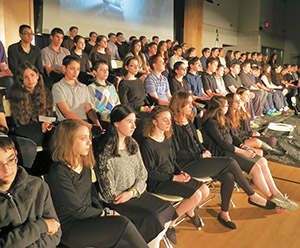


Paramus—As he merged with the crowd exiting the middle school auditorium, there were tears in his eyes. “I’m thinking of all my brothers and sisters,” he said to me. “They were so little….”
We were leaving the Yeshivat Noam Yom Ha’shoah program, an innovative and original presentation by the eighth grade, and I was holding onto the arm of my father-in-law, Jack Gross, a survivor who lost his entire family—his mother and six siblings (his father was “lucky” to die of appendicitis before the war)—in Auschwitz. My mother-in-law Pearl, also a survivor, was with us as well, and we had all just watched their grandson, my son Darius, present her story. For her, the evening was a peculiar experience, disorienting and deeply moving at the same time.
Yeshivat Noam’s “Eighth Grade Living Museum” is a program designed to teach the students about the Shoah in an impactful, personal way. “The Shoah is not a topic that can effectively be taught to middle school children in a regular fashion,” said Yeshivat Noam’s social studies teacher Rabbi Jeremy Hellman. He feels that Yom Ha’shoah programs usually present the larger picture, but the sheer scope of devastation can overwhelm children at that age, making it unrelatable. In response, three years ago, Rabbi Hellman and Yeshivat Noam Assistant Principal Becky Troodler sought to create a Holocaust curriculum that would personalize the experience for the students, and address the poignant fact that with every passing year there are fewer survivors around to tell their stories.
Enter Rebecca Lopkin. Founder and Artistic Director of Envision Theater, Lopkin works with schools throughout the New York/New Jersey area to enhance a particular area of study by creating interactive programs personalized to fit each school’s needs. Lopkin worked with Yeshivat Noam to create a program that would be meaningful for the students, and has continued to work with the school to develop and expand its Living Museum Program over the past three years.
The Yeshivat Noam Living Museum was an interactive experience this year, both for the presenting students and for the audience. It began with a presentation by the eighth grade in the middle school auditorium. The students held a candle-lighting ceremony, several recited poems that they had composed and there was a dramatic reenactment of a timeline of the Shoah in scenes performed by the students. Afterwards, the eighth graders read off the names of survivors who were the subjects of the evening’s program, and the audience was directed to classrooms, to hear their stories.
By breaking up into these smaller groups, the program took on a more intimate tone. In each classroom, five or six students stood in a row and, one by one, told the story of a survivor he or she had interviewed or researched. Each student had prepared a narrative presentation, photographs, an original graphic arts representation of the story and, in some cases presented an artifact. All shared a “diary entry,” a creative writing piece in the voice of the survivor being represented. In this small group setting, after hearing several stories, everyone in the room was invited to examine the students’ displays and to ask questions.
Most had interviewed someone in their own families for their presentations, and about half had interviewed a survivor firsthand. My own son had interviewed his grandmother; she sat between my husband and me in the small room, feeling a bit self-conscious as Darius presented her story to the group. My in-laws were among a handful of grandparent survivors in the audience.
To the students who researched and presented, and to the sixth and seventh graders who experienced the program earlier in the day, “this program has made the Shoah much more real than just reading about it in a textbook,” explained Rabbi Hellman. “They learn about the Shoah as part of the curriculum in middle school, but these presentations help the children to connect with individual stories.” Viewing the photographs and hearing the “diary entries” attempted to put them in the survivors’ shoes. Yeshivat Noam principal, Rabbi Chaim Hagler, expanded on this thought. “We still bring in survivors to speak every year,” he said. “But we’ve found that for our sixth and seventh graders, hearing an eighth grade peer give voice to a survivor has a different impact on them, because they hear the story in a language that they can really relate to.”
The eighth grade students worked on their projects for months, meeting regularly with Ms. Lopkin to create the performance element of the program. Meanwhile, Rabbi Hellman focused on the survivor interviews with his students, placing emphasis on the thoughtfulness and artistic integrity of their creative projects. He also spent a lot of time guiding the students in how to present their stories in a sensitive, meaningful way. “Aside from the learning experience, one of the most significant results of this program is that we teach our eighth graders that they can give a voice to the past,” commented Rabbi Hagler. “We make them realize that they have the power and tools to research and learn about our history—and also that our history is continually being written.”
As we left the auditorium after the conclusion of the program, my father-in-law reflected on his lost brothers and sisters, and then made a final observation which put everything into perspective. “These children,” he said, pointing to Darius with a group of other eighth grade boys, “they are what—thirteen? Fourteen? That’s how old I was when I ran away to hide.”
By Abigail Hepner Gross










